What causes a blockage in a pipe? The cause of the blockage may be a rag that accidentally fell into the toilet bowl in the toilet, or fat deposits in the sewer pipes in the kitchen, or long hair in the bathroom drains. When a blockage occurs, water flows poorly through the sewer pipes or does not drain at all. This can lead to flooding, which is highly undesirable.
Therefore, it is important to determine where the blockage occurred and try to remove it on your own. Well, if you can’t handle it yourself, then you’ll have to call a plumber.
So, you have a blockage in your pipe: how to clean the pipe and remove the blockage?
First actions
Wherever a blockage occurs, the first thing to do is:
- Remove visible objects that caused the blockage: hair and other debris.
- If the clog occurs in the sink or bathtub, fill it with water. Pre-close the overflow guard, if equipped, with a wet rag or tape. This is necessary to ensure that the pressure created by the plunger does not decrease.
- Then take a plunger that we know well, place it over the drain and, pressing on the handle of the plunger, inflate several times.
Note!
When pumping, the plunger should not come off the surface of the sink, bathtub or toilet. You need to sharply tear off the plunger at the end of the inflation process.
- Then quickly pull the plunger out of the sink. The blockage should move under the influence of the forward movement of water. If this does not happen, repeat pumping with the plunger several times.
- If there is a blockage in the toilet, use the plunger to perform the same movements.
Advice! To ensure a better fit of the plunger to the surface of the plumbing fixture, its edges can be lubricated with Vaseline.
Removing a clog in the toilet
To remove a clog in the toilet, you can use another method in addition to a plunger:
- Take a whole bucket of water and quickly pour it into the toilet. Water will create more pressure than with normal flushing, and will attack the clog, which usually consists of feces with toilet paper.
If this does not help, then take a break and try again after a few hours. This will eventually remove the clog from the toilet.
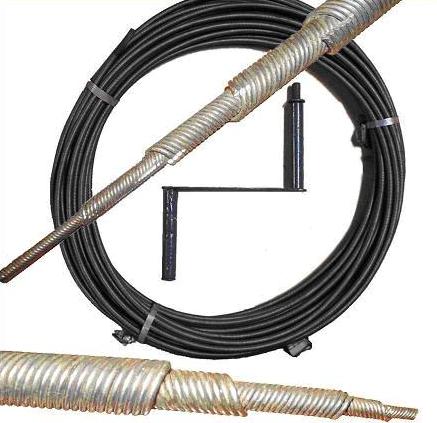
How to clear a clog in a pipe if a plunger doesn’t help?
For more serious pipe clogs, use a plumber's rope. A plumbing cable is a special tool that plumbers use. But you can purchase it for your own use.
It is a steel twisted spiral spring made of several layers wound on each other in opposite directions. The cable can be equipped with a Z-shaped handle. Its main task is to hook and pull out the blockage from the pipe.
To remove the blockage, you need to remove the siphon and clean it if there is contamination. Then we take the plumbing cable and insert it into the pipe. Carefully push it through the pipe. As soon as the cable hits something, turn the handle clockwise.
Most likely, you hit a bend in the pipe. Push the cable further until you find a blockage. Try to break through the blockage with a cable and twist the debris around it. Then pull the cable to the surface and remove any dirt from it. All you have to do is assemble the siphon and check the pipe for blockages. Turn on the hot water and flush the pipe.
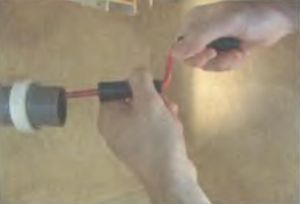
Note!
If your bathroom drain is clogged, the easiest way to remove the blockage is through the overflow system.
Before using the cable
Chemicals can be used to remove clogs in sewer pipes.
But before you do this, try removing the clog mechanically, since chemicals can have a destructive effect on sewer pipes, and the vapors of these compounds have a negative impact on human health.
You can use the following chemicals: Domestos, Mister Muscle, Pothan, Typhoon and others.
Such products are sold in any supermarket. As a rule, the product is poured into the sink and left for several tens of minutes. Look in the instructions. But this time is not enough to dissolve the blockage, so we recommend leaving the product for several hours. This time will be enough to remove serious blockages.
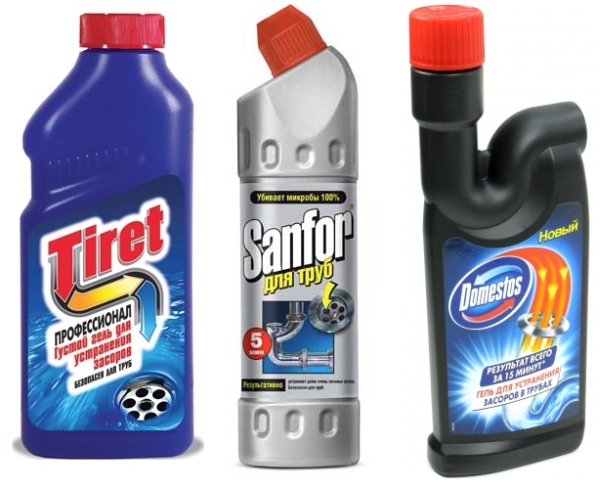
- In order to clear the blockage, take 9 percent vinegar - 1 liter, 5 tablespoons of baking soda.
Pour baking soda into the drain hole, fill it with vinegar, and wait until the chemical reaction takes place. Then rinse it all with boiling water. This way you will get rid of the blockage.
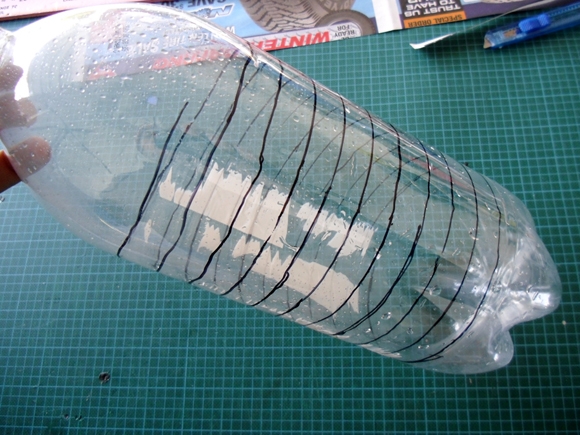
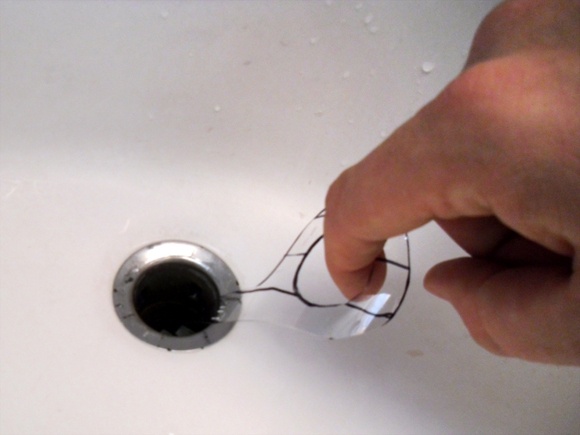
- We insert it into the drain hole until it stops. All you have to do is pull the handle and pull the debris out of the pipe. This hande-made solution is suitable for small and medium-severity blockages.
- To clear a blockage in a pipe, you can use regular boiling water. Pour boiling water into the drain hole until the pipe is clear. This can take several liters of boiling water. But, as a rule, boiling water quickly dissolves clogs from organic deposits.
Preventing blockages
To prevent blockages in pipes, you can use the following method:
- Take 1 cup of regular baking soda, 1 cup of salt and a quarter cup of cream of tartar.
- Mix all ingredients and place in a clean jar, close tightly with a lid.
- Then, for a one-time procedure, take a quarter of the mixture, pour it into the sewer pipe and pour a glass of boiling water over it.
- Wait 1 minute. Rinse the pipe with cold water. Repeat the procedure every week.
If there is already a blockage in your sewer pipe, then you can remove it with your own hands using different methods: flushing pipes with boiling water, pumping with a plunger or plumbing cable. IN as a last resort, call a plumber. But also do not forget about preventing blockages - a simple procedure that will prevent their occurrence.
Cleaning a sewer in a private home is a procedure that every property owner should be able to perform. After all, the drain system is clogged dirty water significantly reduces the comfort of living in the house and creates a lot of problems for its residents. Let's look at the most effective methods cleaning your home pipeline with your own hands.
Common methods of cleaning pipes - how to make your life easier?
No matter how hard you try and maintain your pipes, sooner or later you will find that you have a clogged drain. main reason– not only hair, paper or other objects getting inside the pipes, but also clogging it with food debris. Even if you try to keep food debris away from the drains in your home, it will still end up inside. Already inside the pipe, they gradually accumulate in the elbows of the drain channels, forming a strong plug, which is not as easy to get rid of as it seems. However, difficult does not mean impossible. It is quite possible to break through the accumulated debris with your own hands. But to do this, you will need to learn several simple methods for solving such a problem.
Firstly, if the sewer is clogged, then the problem can be solved using one of three popular methods. The first is to clean the drain hole and pour several liters of clean boiling liquid inside the pipe. After this, you need to wait about 20–25 minutes and clean the channels with a plunger. Next, take 2 cups of soda, pour them into the drain hole, and after the soda, pour 2 liters of boiling water. It is possible that if the sewer system in a private house is clogged with a large amount of garbage, it will not be possible to clear it the first time. Therefore, the procedure must be repeated until the channels are completely cleared of accumulations. In the process of cleaning the sewer, soda will not only dissolve debris, but also remove pathogenic microbes from the walls of the pipes.
To clean the channels yourself, you can also use a mixture of soda and vinegar. To do this, you need to pour 100 g of soda and 100 ml into the drain hole. table vinegar. During the mixing process, these components will create abundant foam, which will push debris further along the channels. After 3 hours, the pipeline can be washed with several liters of boiling water. This method will help eliminate a large number of blockages that have managed to form on the walls of the channels.
A mixture of soda and salt will help solve the “sewage” issue. To do this, you will need to mix both components in a glass and pour them into the drain hole. Immediately after them, pour boiling water inside and wait 7–9 hours. During this time, no water should enter the pipes. To prevent debris from clogging, the pipes must be flushed from time to time. hot water. It is important that the water is boiled. Otherwise, scale from the bleach contained in tap water will form on the walls of the water supply.
A plunger and a cable are faithful assistants in guarding the cleanliness of the channels
Debris that can clog the water drainage channel can be quite easily pushed through the pipes using special devices. The first of them is the plunger, which is familiar to each of us. It is especially effective in cases where the siphon connecting the toilet or sink with the toilet tends to become clogged. drain pipe. The rubber part of the device creates pressure, which easily moves debris inside the channel until it is completely cleared. Often after the procedure, parts of the debris rise to the drain hole, which makes their removal easier.

- 1. if you need to pierce a pipeline in a bathtub or sink equipped with an overflow hole, then the hole will need to be tightly closed to ensure the tightness of the sewer;
- 2. After this, place the rubber “cap” of the plunger over the drain hole and press it as tightly as possible to the sink;
- 3. you will need to make several translational movements up and down, increasing the pressure between the plunger and the sink;
- 4. then sharply pull the tool from the surface;
- 5. If the debris does not begin to pass further, the procedure should be repeated.
It is worth noting that today in stores you can purchase more effective adaptation, resembling a pump. With it you can create high pressure with fewer movements. If there is a very hard blockage inside the pipes that cannot be removed by a plunger, you can try to remove it using a steel cable. This device will also be effective in cases where debris has accumulated far from the drain hole. A basic cable for removing accumulations is made of wire twisted into a strong, elastic and flexible spring. One end of the tool is equipped with a handle for easy rotation, and the other has threads for various attachments that can destroy a lump of debris.
Before cleaning, check the cable for damage. This will ensure that the tool does not crack and that part of it does not remain in the pipes. Also evaluate the strength of the handle and its fastenings. Then we install the nozzle and lubricate the moving elements of the wire.
After making sure that the cable is in good condition, you can begin to directly clean the clogged sewer. First, disconnect the siphon from the sink and insert the cable into the sewer channel. The tool should enter towards the center drain. Make sure the wire goes deep inside the pipes. Only then can you rotate the tool. This must be done clockwise, as the spring may unwind and come off. It is very important not to overdo it when pushing through the clog, otherwise you will damage the walls of the canal. This is especially true for plastic pipes.
As soon as you reach a lump of debris, reduce the amplitude of rotation of the cable and try to destroy and push the “plug” further along the channels. If you have a hook-shaped attachment, you can use it to pry the clog and pull it out through the drain hole. Once the problem is resolved, you will need to flush the drain with plenty of boiling water, otherwise the problem area may become clogged within a couple of weeks. If a funnel forms in the sink when draining liquid, it means your drainage system completely cleared of blockages.
Chemicals for clearing blockages - recommendations for use
If necessary, you can clean the sewer with special chemical compounds. There is a very wide range of cleaning products on sale, which is gradually increasing. Choosing the most effective of them is quite difficult, since each composition has its own pros and cons. Experts consider the domestic product to be one of the most effective means. Minute gel. This composition allows you to quickly and easily get rid of blockages of any complexity. Even if the most remote areas of the pipes tend to become clogged, the gel will quickly reach them and destroy the garbage “plug”. The average price for a gel is about 40 rubles.
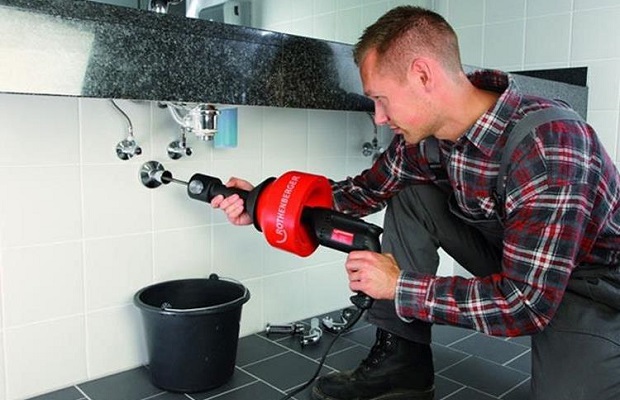
Another high-quality composition- This Tiret. The cost of the product is around 300 rubles. Among the advantages, it is worth highlighting the ease of use of the composition. All you need to do is pour one measuring cup of product into the drain hole and wait no more than 20 minutes. After this, you need to rinse the pipes with hot water. The next good option for cleaning channels is considered Floop. It is popular due to its effectiveness and low price - about 75 rubles. per jar. To clean, you need to pour an anti-clogging compound into the pipes, immediately after that pour a little cold water or boiling water. Then you will have to wait about 10 minutes, after which you need to clean the drain with plenty of water.
One of the most popular compositions is Mole. This inexpensive product has a lot of advantages, including efficiency, elimination of harmful bacteria and cost-effectiveness. The cost of the composition ranges from 100 rubles. for a 1 liter jar. The only drawback is the need to wait several hours before you can flush the channels with water. Such a composition for cleaning drains as Chistin, is on the market relatively recently. However, it has managed to establish itself as an effective gel that allows you to break through any blockage in a matter of minutes. It does not destroy the walls of plastic pipes and kills pathogenic bacteria in them. The cost of a jar of the product is from 50 rubles.
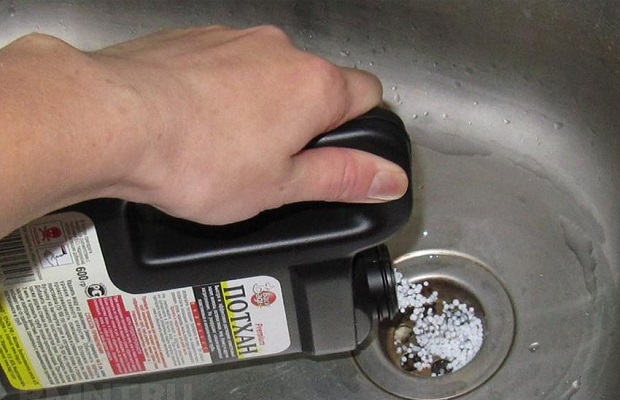
If you have ever wondered: “How to clean a sewer in a private house?”, then you should pay attention to the well-known composition Mr. Muscle. Before using the product, you need to wipe the surface of the sink from moisture, pour powder into the drain holes, add a little boiling water to the powder and leave the pipes for 45 minutes. After this, the drain can be cleaned with hot water. The price of the product is approximately 100 rubles.
Pros and cons of compounds for removing debris from pipes
Each household product for drain cleaning has advantages and disadvantages. So, Mr. Muscle It is highly effective, but its cost is slightly higher than its analogues. In addition, many handicraft enterprises produce their own version of the product, which is significantly inferior in quality to the original. In the case of products Floop its cost is significantly lower than that of its competitors, but this product does not always cope with severe blockages. The composition is often used to clean channels leading to the kitchen - it easily dissolves blockages from food residues. At the same time, he will not be able to deal with clumps of hair that have clogged the pipes under the toilet or bathroom sink.

One of the most suitable in the price-quality category is the product Tiret. It easily tackles even the oldest and toughest clogs. In addition, this composition is often used for preventive purposes. The only negative is the very high cost of one can of the composition. Having considered the pros and cons of each of the compositions, we can conclude that the most effective and inexpensive product on our market is Mole. This product has an optimal formula and is absolutely safe for the health of residents. The product is very easy to use both for cleaning and for preventing blockages.
Sooner or later, every owner encounters clogged pipes in an apartment, and in most cases you can do without the help of a professional plumber.
The need to clean the sewer is indicated by a decrease in the speed of water flowing through the drain and the presence of an unpleasant odor from the sink or bathroom.
Blockage in pipes: reasons
Cast iron sewer pipes are still found in older houses. This material is susceptible to corrosion, the inner walls become uneven over time, and a coating of rust forms on them. Most often, blockages form in the following potentially dangerous places: the outlet section kitchen sink before release in the bathroom.
If in an apartment plastic pipes, the cause of the blockage may be improper installation, that is, failure to observe the slope of the pipe towards the riser. This leads to the formation of plaque inside the pipes. One of the most common causes of clogged pipes is grease. Over time, it settles on the inner surface of the pipes, retaining small debris, food debris, etc., such sediment gradually becomes denser and reduces the throughput of the pipe.
The cause of clogged pipes may be improper installation or failure to comply with the pipe slope. A foreign object may enter the system; as a result of long-term operation, a thick coating forms on the inner walls of the pipes. Pipes also become clogged due to improper or lack of proper maintenance.
There are several ways to clear clogged pipes at home, using folk remedies, chemicals and mechanical devices. If the water begins to drain slowly through the drain hole, a bad smell in the kitchen or bathroom, a rise in water is noticeable under the drain grates of the sewer when the pressure is turned on, the blockage needs to be removed.
Most often, pipes become clogged in the summer-autumn period, which is associated with much greater water consumption and an increase in the amount of garbage entering the sewer system. You should be especially careful during the period when harvesting for the winter is being done and it is advisable to have on hand something that can be used to clean the pipes.
How to clear clogged pipes at home: necessary tools and equipment
Understanding how to clear clogged pipes at home, we list the methods and devices that can be used for this:
1. Mechanical methods.
The easiest option is to use a regular plunger. Almost everyone has this tool in their home and it can easily deal with a simple blockage, for example, if the sink is clogged with small particles of dirt, debris and grease.
More complex blockages will have to be cleaned in a different way. In this case, use a plumbing cable approximately three meters long with a peak-shaped nozzle at the end. However, it should be remembered that the cable is not suitable for chrome, brass and plastic siphons.
You can also use a brush or wire to clean pipes.
2. Chemical methods.
How to clear clogged pipes at home using chemicals? Buy a product in a store, read the instructions for use on the label and follow it. As a rule, the liquid is poured into the sink, left for half an hour and washed off with plenty of hot water. These can be gels, liquids, alkalis, acids or powders (Mole, Mister Muscle, Tiret, Silite). These products contain sodium hydroxide.
The principle of action of the chemicals is to “corrode” deposits on the inner walls of the pipes. The use of these products is completely safe for plastic and cast iron sewer systems.
Chemicals should be used with caution: wear rubber gloves on your hands, it is advisable to cover your face with a mask so as not to burn your mucous membranes when the chemicals evaporate.
It is recommended to use chemicals for cleaning pipes at least once every 2-3 months, then you will be able to avoid costly replacement for a long time sewer system.
How to clear clogged pipes at home: in the bathroom
How to clear clogged pipes in the bathroom at home using a plunger? The bathroom, unlike the sink, is equipped with a safety drain hole. It must be closed before cleaning. Using a plunger, a hydraulic shock is generated, which displaces the accumulation of dirt down the pipe from the narrow place of the drain, where a blockage most often forms. First, you need to fill the bath with enough water to cover the cup of the plunger. Place the plunger over the drain hole, press it tightly to the hole and sharply press the handle 3-4 times and sharply remove the plunger from the water. Repeat if necessary until water begins to flow freely.
You can clean the bathtub with a brush, for which you insert it into the sewer hole and use sudden movements to break through the clog that has formed. If necessary, you can attach a brush to a flexible rod to extend the structure and reach the blockage at great depths.
If a plumbing cable is used for cleaning, the siphon is turned out and the cable is inserted into the drain hole as deeply as possible. At the same time, it is rotated in both directions. Screwing into the pipe, the cable clears all blockages, the debris moves down the drain and is washed out. At the end of cleaning, all elements of the drain channel are washed and the siphon is cleaned.
If you don’t have wire or cable on hand, you can take an electric drill or screwdriver, which can also effectively help deal with the blockage.
Now let’s look at how to clear clogged pipes at home using traditional methods safely and effectively. Baking soda is great for this purpose. This is the cheapest and easiest method that any housewife can use without waiting for the help of a plumber.
You need to take soda and vinegar in equal proportions, for example, one glass each. Soda is poured into the drain hole and then vinegar is poured on top. The hole is closed with a stopper and left in this state for 2-3 hours, after which the pipe is washed with hot water. This method of clearing blockages is completely safe for pipes. It can be used not only to remove existing blockages, but also for prevention.
Let's look at a few more solutions made from soda that will help get rid of the blockage. To do this, take about 150 g of soda and heat it on cast iron frying pan about 15 minutes. After it has cooled completely, dilute it with a glass of water and stir thoroughly. This composition can be compared in effectiveness with the well-known store-bought chemical “Mole”.
Another safe way clean the drain - using regular lemon. To do this, take a few lemons and squeeze them directly into the drain hole. Let sit without opening the water for at least an hour. If you don't have lemons, you can use half a cup of lemon juice concentrate. This method is also quite effective.
If a blockage of grease has formed in the sink, you can prepare a strong salt solution. It is poured directly into the drain hole and they begin to clean the drain with a plunger. To ensure a better fit of the plunger, its edges can be lubricated with an inexpensive cream.
A simple blockage in the drain can be removed with a powerful vacuum cleaner using its blowing function.
How to clear clogged pipes at home: in the kitchen
Let's talk about how to clear clogged pipes in the kitchen at home. First you need to understand how the siphon in the sink works, since in many cases you can limit yourself to just cleaning it.
The most common are bottle siphons, the diameter of which is 32 or 40 mm. The smaller the diameter of the drain hole, the faster it clogs. The design of siphons includes a removable part resembling the bottom of a bottle. Removing a blockage in the sink with such a siphon will not be difficult. No special tools are needed to unscrew the removable part.
So, unscrew and remove the sump, first placing a bowl or bucket under it so that the remaining water does not spill onto the floor. Next, using a wire with a hook at the end, we clean the siphon.
Other types of siphons can also be used in sinks. Pipe - made in the form of a curved tube. Quite often there are corrugated siphons, which are easy to bend and can be installed in non-standard conditions. Siphons with overflow are installed in sinks with a special hole to drain excess water. If you are connecting a dishwasher or washing machine, double or triple siphons are used. There are hidden siphons that are installed in a box.
To prevent your sink from clogging, you can place a plastic mesh over the drain hole. You can install a garbage grinder that shreds all the waste that gets into the sink, and then the small debris is washed down the drain. A garbage grinder will eliminate the need to frequently clean pipes; it can easily handle not only soft waste, but even grinds bones and operates silently. It does not take up much space and does not need special care, a simple rinse with cold water is sufficient.
How to clear clogged pipes at home without ruining them
It should be borne in mind that using chemicals to clear clogs can cause harm to plumbing equipment, aluminum pipes and sinks. The fact is that some chemical reactions proceed with the release of a large amount of heat. It is not recommended to lean over the sink and look into the drain hole if gurgling noise is clearly heard. This indicates a reaction is occurring and can be dangerous.
It is important to remember that you should choose chemicals for drain cleaning based on the material of the water supply and the type of contamination. Suitable in most cases universal remedy“Mole”, which copes with various types of pollution.
The use of plumbing rope is suitable for cleaning metal pipes, since it helps to effectively remove, including rust, from pipe walls. Plastic pipes can be damaged as a result of increased mechanical stress. They need to be cleaned with extreme care. On my own this material It is not subject to corrosion, and dirt does not stick well to its surface. But over time, grease gradually clogs the drains and when the need arises to remove the blockage, it is best to use chemicals or a plunger.
Baking soda is an excellent remedy for clearing clogs in sewer pipes. We will talk about how to clean pipes with soda and whether it is safe for the sewer system in this article.
Causes of clogged pipes
There are not many reasons for clogged sewer pipes. They are:
- non-compliance with installation rules (incorrect pipe slope and use cement mortar, for example, when installing a toilet);
- foreign object entering the pipe body;
- the formation of a thick layer of build-up on the inner walls of the pipe as a result of long-term operation;
- implementation improper care or its complete absence.
To improve the functionality of the sewer system, it is necessary to remove the blockage. And the sooner this is done, the better, otherwise an unpleasant musty smell may form, which will be very difficult to get rid of. This can be done either independently or with the help of a specialist plumber. However, his services cost a lot of money, so cleaning pipes at home is a best option clearing the blockage.
Methods for clearing blockages
There are several ways to clear a blockage:
- chemical (professional and home remedies);
- mechanical.
Chemical ready-made products
The chemical method involves the use of chemical-based products, the composition of which “corrodes” the deposits formed on the inner walls of the pipes. These products are capable of eliminating blockages in a short time, while they are completely safe for the sewer system, regardless of what material it is made of (plastic or cast iron).
However, their use is unsafe for humans. They should be used very carefully. It is mandatory to wear rubber gloves on your hands, and preferably a mask on your face. Since chemicals have the property of evaporation, their vapors can cause burns to the mucous membranes of the nasopharynx and eyes.
To avoid costly replacement of the sewer system, you need to use any chemicals at least once every 2-3 months industrial production with the specific purpose of sewer cleaning.
Mechanical method of cleaning pipes
This method involves using one of the following tools:
- plunger;
- wire;
- cable plumbing.
If the blockage is not severe and shallow, then cleaning the pipes at home can be done using a regular brush, which is available in every home. To do this, you need to insert it into the sewer hole and try to break through the sewage with sharp pressing movements. If the range of the blockage exceeds the length of the brush, you can use a flexible rod by attaching the brush to it. The resulting structure must be pushed deep into the sewer pipe to break through the blockage.
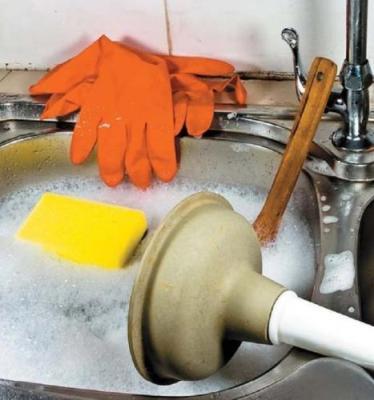
A plunger is also a great item to break through sewage and clear a passage for water to drain. To do this you need:
- Use the bowl of the plunger to completely close the hole for draining the water, trying to completely block the access of air under it;
- pour water into the bathtub or sink so that it completely covers the bowl of the plunger;
- make 20 sharp vertical movements, holding the plunger handle at a slight angle;
- quickly remove the plunger from the water.
This method of cleaning pipes must be done until the blockage is completely removed.
How to clean pipes at home using wire or cable? It's very simple, all you need is:
- put gloves on your hands;
- disassemble the siphon under the sink;
- lightly insert a cable or wire into the sewer hole;
- Push the wire or cable in a circular motion, gradually moving forward until the wastewater is completely pierced.
If you do not have a cable or wire at hand, then in this case you can use a screwdriver or electric drill. They will effectively cope with the task.
Traditional methods of cleaning the sewer system
Now let’s talk about how to clean pipes with folk remedies, and in particular with soda. This method is very simple, any housewife can use it. To do this you need:
- take in equal quantities baking soda and vinegar (one glass will be enough);
- pour soda into the sewer drain, pour vinegar on top;
- close the drain with a stopper and leave to act for 2-3 hours;
- Rinse the drain with several liters of boiling water.
Baking soda has been used for cleaning pipes for many years. This method is one of the most effective and safest. Does the job perfectly without causing any harm internal surfaces sewer pipes.
Cleaning pipes with soda can occur both when clogged and for prevention.
One more the folk way is the use of regular lemon. You need to squeeze a few fresh lemons into the drain hole and leave the pipe empty. running water at least for an hour. You can replace the fresh lemons with half a cup of lemon juice concentrate.
To avoid costly replacement of the sewer system, it is necessary to carry out preventive cleaning of the pipes at least once a quarter.
All household waste goes through sewer pipes. Everyone gets food debris, hair and other debris into the water. All this causes blockages even in smooth plastic pipes. Tips on how to clean a sewer at home will help you cope with the situation yourself.
A clogged kitchen drain is a common situation.
What causes a blockage to appear?
Water standing in the sink or bathtub and the appearance of an unpleasant odor are signs of a blockage in the sewer pipe. Common reasons for its appearance are:
- operating a kitchen sink without a mesh;
- large debris getting into the toilet;
- fat accumulation in the pipes;
- insufficient slope of the sewer line.
- V autonomous system Freezing of a section of pipe or damage to the system may occur.
During operation cast iron pipes Over time, their diameter significantly decreases due to deposits and corrosion on the walls. A line with a cross-section smaller than the required one quickly becomes clogged and requires thorough cleaning.
Attention. Areas prone to frequent blockages include: outlets kitchen sinks, bathtubs and toilets.
Simple ways to deal with blockages
The sewer system in a private house is clogged, what should I do to quickly restore its operation? This question arises for everyone from time to time. Removing a garbage jam does not always require the use of complex methods and special tools; it is worth trying to solve the problem with simple and accessible means.
plunger
Every family has this common plumbing tool. It consists of smooth wooden handle and a rubber bowl at the end. Cleaning sewer pipes with a plunger is performed according to the following scheme:
- If there is not enough water in the sink, you should fill it up to the height of the bowl.
- The device is pressed against the drain hole, and translational movements are made up and down.
- Next, the plunger rises sharply; if the water quickly flows into the hole, then the work is finished. If necessary, movements with the device are repeated several times.
The pressure created by the plunger forces the debris to move and continue moving through the pipe.
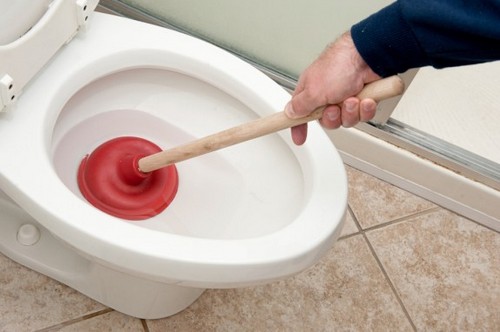
Using a plunger to break through a clog in the toilet
Advice. If there is an overflow, it is necessary to close the hole with a plug, otherwise it will not be possible to create pressure in the system.
Draining boiling water
The main reason for clogged pipes in the kitchen is a large amount of grease settling on the walls. Hot water effectively dissolves such deposits, so it is worth opening hot tap and try flushing the system.
Read also:
Simple and effective means - soda and vinegar for cleaning pipes
A folk remedy - a solution of soda and vinegar - will help dissolve fat. This method is very simple and everything you need is in the kitchen. Before cleaning the drain with soda and vinegar, you need to prepare a rag to plug the drain. To work you will need:
- a glass of soda;
- a glass of 9% vinegar;
- cork.
Soda is poured into the dry sink drain and vinegar is poured. The hole is quickly closed with the prepared object. The substances enter into a violent reaction, during which deposits on the pipe walls are broken down. An equally effective substitute for vinegar would be lemon acid, which gives an active reaction when interacting with soda. After some time, the drain is flushed with hot water.
Pipe cleaning methods
All measures to clear pipes from blockages are carried out in one of three ways:
- mechanical cleaning - performed using a special tool;
- chemical cleaning - active reagents in the form of powder, solution or gel decompose waste;
- hydrodynamic cleaning - operates using water pressure under pressure.
Mechanical tools
The use of a plunger is also considered mechanical cleaning; if its use does not produce results, they move on to a plumbing cable. It allows you to deal with debris that has accumulated at a great distance from the drain. The sewer cleaning cable is made independently from metal wire. The factory version is made of a flexible spiral and ends with a handle. You can enter it through the inspection hatch, or by removing the siphon under the sink.
Plumbing cables vary in diameter and length; for use in a private home, a tool with a cross-section of 6-9 mm and a length of 5-6 meters is sufficient. To increase the efficiency of use, toilet attachments in the form of a brush or hook are offered for the cable. The work is performed in a certain sequence:
- It is necessary to cover the floor in the place of work plastic film, and put gloves on your hands. Preparatory measures will protect against contamination by sewage that may flow from the pipe.
- The tip of the cable is inserted into the pipe and carefully pushed inside. During movement, the tool is rotated in one direction.
- When the cable reaches an obstacle, they try to break it into separate fragments using forward movements.
- If there is a major blockage, the cable is removed and cleaned several times. Mechanical cleaning The sewer ends with a large volume of hot water filling the system.
Why there is a smell from the sewer in the apartment and how to get rid of it
Preparations for chemical cleaning
Sewer blockages are divided into several types:
- mechanical - occur as a result of large debris entering the system;
- technological - appear when pipes wear out or design errors;
- operational - accumulate during the use of the pipeline.
If an object that has entered the system can only be removed mechanically, then the operational blockage can be removed. special means. It usually occurs due to the deposition of fat on the walls, which attracts and retains various small debris.
Alkaline preparations
Cleaning sewer pipes at home is possible without using tools or unscrewing fittings. To do this, you need to use one of the chemicals available in huge quantities. The preparations have different consistencies:
- powder - dry substance is easily poured inside the pipe;
- gel – economical and effective remedy, covering the entire surface of the walls and slowly flowing down;
- liquid - used for complex blockages.
Any chemical agent aggressive, you should wear gloves before using it and leave the room after application so as not to inhale the fumes.
Advice. Do not leave the drug in the pipes longer than the manufacturer recommends. The active substance may damage the sewer material. After use, the line is washed with water.
Acids and alkalis are used to remove traffic jams; one of these substances is caustic soda, used for cleaning sewers. It easily corrodes organic compounds, so it should be handled with care. The drug may cause chemical burns. They work with it wearing gloves and goggles, and there should be constant access to fresh air in the room. The technology for cleaning with soda is very simple: two tablespoons of caustic soda are poured into the drain and poured with a glass of boiling water. After 2 hours, the drain is washed with water.








